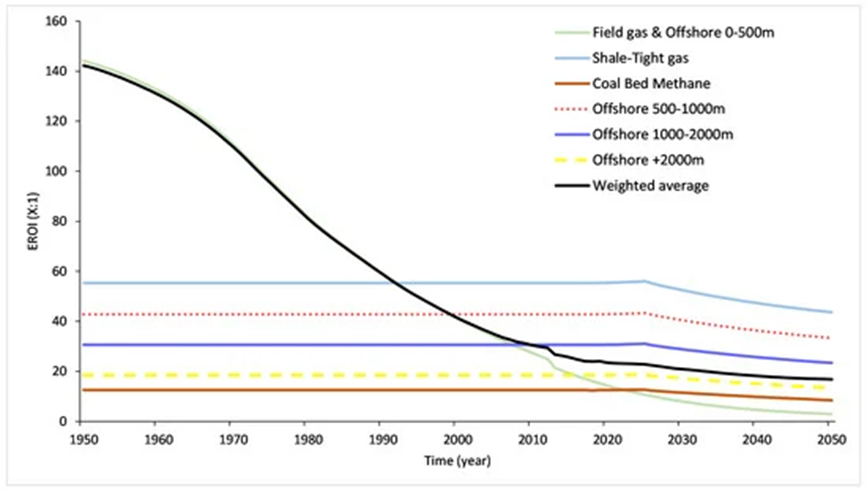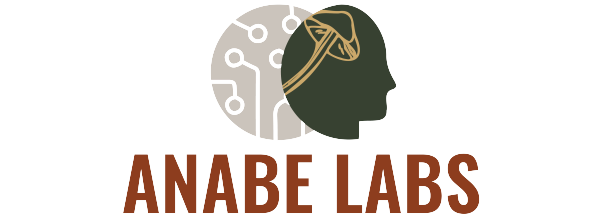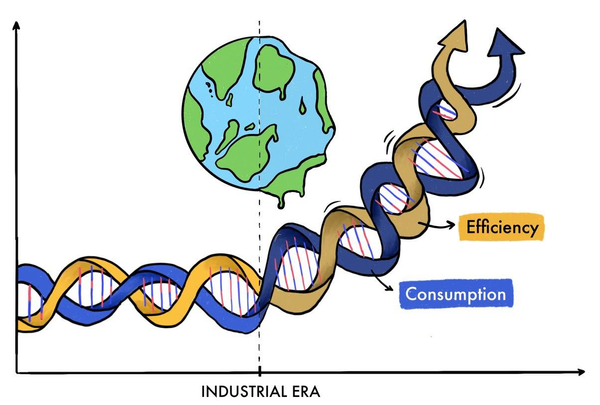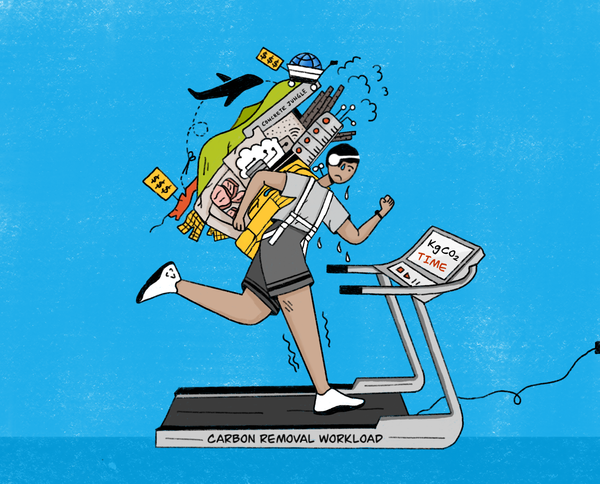EROI perspective on post-2021 energy policies in India
Does ethanol as biofuel and green hydrogen provide energy security and resilience to the masses in India.
Key points from this article:
- → Ethanol blending with gasoline and hydrogen fuel are analyzed through the EROI metric to see if they can substitute or complement existing fossil fuel infrastructure in India.
- → Both ethanol blending and hydrogen fuel only improves energy resilience, not energy security due to their lower EROI compared to fossil fuels.
- → Gas cylinder price in India is predicted for 2024-2040 through EROI inference.
This article is Part 2 of the EROI series. If you are not familiar with the concept of EROI and its implications, it would be better to read Part 1 first. To briefly introduce, EROI (Ratio of energy returned to energy invested) is a fundamental metric used to evaluate the quality of any energy source. Higher the EROI, better is the quality. Through the lens of EROI lets analyze some of the recently implemented energy policies and announcements of the central and state governments in India. These energy policies are analyzed in the context of whether they provide energy security and resilience to the Indian public in the long run.
Ethanol blending with gasoline (petrol)
Ethanol is a biofuel extracted from fermentation of sugars by yeast or via petrochemical processes. Sugar mills procure sugarcane from the farmers, extract the juice from the sugarcane and the residual molasses are processed as a feedstock in the distilleries (some of the mills have in-house) to get ethanol. It is primarily blended into petrol to reduce the quantity of petrol required to run a vehicle, thus reducing dependency on imported crude oil. There has been a gradual increase in the ethanol blending percentage (v/v %) since Modi government took power in 2014. The central government had set an ethanol blending target of 1.5% in 2014 which was increased to 5% in 2018 and then to 10% in 2022[1]. They are planning to go to 20% by 2025.
The pros of ethanol blending: Primarily, the pros are improved energy self-sufficiency (‘Atmanirbhar’) by reduction in foreign oil import, boost to sugar industries who supply the feedstock for ethanol and perceived positive demand signaling to farmers who grow sugarcane. Other pros which are claimed but debatable are the higher-octane number of Ethanol and reduced emissions from the blended ethanol. Let us understand these debatable pros better.
Higher octane number supports the engine optionality to burn the fuel better provided engine tuning (spark timing) and handling of higher compression ratio are already done. It is easier to do these two modifications in newer vehicles as older vehicles need retrofit and calibrations for the same. Also, high compression ratio engines from newer vehicles may face failure from engine knocking when operated with low or nil ethanol content (i.e., pure petrol). Similarly, the older vehicles which were designed for nil content of ethanol in gasoline will result in lower fuel economy if used with higher ethanol blends, as old car engines are not optimized to take advantage of it. Hence the theoretical benefit of higher-octane number is not as advantageous in real world due to pre-existing engine constraints.
Regarding emissions performance of ethanol blended petrol EROI comes into play here. If you look in isolation, on combusting ethanol blended petrol it emits 20-30% lower emissions on average. However, it is good to recall that ethanol has lower EROI than petrol which makes the ethanol blended petrol less fuel efficient from mileage consideration. 1megajoule of energy (MJ) invested in fuel production gives mileage of 5.8 km from pure petrol as compared 3.2km from pure ethanol derived from sugarcane[2]. Hence effective mileage from 20% ethanol blended petrol would be 5.28 km, around 9% lower. So due to reduced mileage vehicles will end up using more litres of blended petrol thereby nullifying the emission reduction and raising the cost for the end consumer.
The cons of ethanol blending: Firstly, ethanol production mostly relies on sugarcane molasses as feedstock. Other grain feedstocks like leftover rice, corn and maize are considered ‘low quality’ due to their much lower EROI as compared to sugarcane. To meet the domestic ethanol supply requirement for 20% blending target by 2025[3], allocating more arable land in India for sugarcane cultivation is required. Since the sugarcane cultivation is water intensive this land allocation becomes highly questionable from food and water security consideration. Growing pulses and veggies instead on that land would be more nutritional for the masses and would curtail sugarcane monoculture and help maintain balanced biodiversity. Alternatively allocating this land for solar panels would yield higher EROI.
Secondly, the government is providing subsidy to the sugar and ethanol industries to ramp up the ethanol blending percentage, but no assistance to farmers. The sugar mills can divert all the sugarcane feedstock totally to ethanol production in their in-house distilleries to take advantage of the subsidy and make more profits. The sugarcane farmers in Maharashtra, who are getting paid Fair Remunerative price (FRP) for their produce, argue that FRP is not sufficient to meet increased cost of living and cultivation and it would be fair to get surplus revenue sharing from sugar mills under the new ethanol blending programme[4].
This raises the question whether the pros outweigh the cons? It is not clear cut as this policy decision gives a business boost to sugar and ethanol producing industries at the expense of slightly higher petrol cost for the masses. The decision seems more pro-big industries than pro-masses, like most decisions from the central government. Consumers and farmers are not getting the financial upside (‘paisa vasool’) from this policy and we need to rightfully protest if ethanol blending in petrol is taken beyond 20% in India. Ethanol blending is comparable to chicory mixed coffee for lack of a better analogy. Chicory does provide supplementary benefits (reduced bitterness, colour and aroma enhancement) to your coffee but you are paying primarily for the coffee beans!
Gas cylinder subsidy in India
India still imports almost half of its domestic gas requirement[5] which makes it dependent on the fluctuation of the global natural gas prices. Further, the price of gas cylinder can be masked by macro factors like subsidy from the government or short-term supply manipulation in the market but the EROI trendline of natural gas is a more stable and reliable inverse indicator of the price in the long term.
The graph below in Figure 1, taken from a recent research paper[6] on historical and long term EROI modelling of natural gas, shows a decline of global EROI of natural gas since 1950 (black line in the graph) and the decline is expected to go on until 2030-2035ish and then a plateau from then on. When EROI of any fuel declines it means that we have less energy output for the same input, thereby increasing the cost to procure and transport the fuel to the end consumer.

This is a clear sign that we can expect gas cylinder price to go higher (10-30%) from current prices until 2035 and then sustain there in the foreseeable future. We cannot expect the Indian government to avoid this irreversible trend irrespective of political party and their campaign promises. Subsidy intervention from the government can only briefly stabilize the gas cylinder prices but is better for citizens of India to brace up for sustained higher prices of gas cylinders due to the inevitability of its declining EROI trend. If you are wondering about the flat coloured lines in the graph, they are for deep offshore exploration which have been relatively untapped in the past (as compared to surface level field gas) making their EROI remain almost constant, until they are expected to be tapped around 2030.
Green hydrogen promotion in India
The National Green Hydrogen Mission[7] was launched by the Indian government in January 2022 to make an initial roadmap to develop hydrogen fuel production for decarbonization, energy self-sufficiency (‘Atmanirbhar’) and job creation. Unlike the previous two policies, the green hydrogen policy is not yet fully operational with limited demonstration projects being implemented nationwide to showcase its feasibility.
It would be good to know the three types of hydrogen fuel before we analyse the EROI of green hydrogen. Depending on the nature of the method of its extraction, hydrogen fuel is categorized into three categories, namely, Grey, Blue and Green:
- Grey hydrogen: It is produced via coal or lignite gasification or via a process called steam methane reformation (SMR) of natural gas. These tend to be mostly carbon-intensive processes.
- Blue hydrogen: It is produced via natural gas or coal gasification combined with carbon capture storage (CCS) or carbon capture use (CCU) technologies to reduce carbon emissions.
- Green hydrogen: It is produced using electrolysis of water with electricity generated by renewable energy in the grid. The carbon intensity ultimately depends on the grid intensity (i.e., the more renewable energy there in the grid, "greener" the hydrogen produced)
It needs to be noted that hydrogen fuel industry is nascent with its EROI mostly being estimates and not validated from real world operational data. EROI estimates of the three types of hydrogen, taken from a recent research paper[8] is shown below along with their emission intensities[9,10]:

The above combination of EROI and emission intensity values show that why green hydrogen is preferred over its counterparts. Yet the EROI of green hydrogen is still lower than of average EROI range of 15-20 from conventional oil or natural gas in its current global reserve levels. This shows that green hydrogen can be used to decarbonize certain industrial processes (replace grey hydrogen for fertilizer production, substitute coke as feedstock for steel production) but it is not a complete substitute for fossil fuels.
Smog tower installation in Delhi
Smog tower is not an energy production technology per se to evaluate under the lens of EROI as it is an industrial scale unit to purify air. Still, it is worthwhile to briefly discuss about its efficacy and whether energy allocation to building and scaling such units is justified to combat air pollution in Delhi or even for other cities in India.
Two 25m tall smog towers were installed in Delhi in 2021. These towers vacuum out the particulate matter from air and sends them through industrial HEPA filters to release filtered air as depicted in the image below. This project was a pilot study from the Delhi state government (under Kejriwal) to test the efficacy of smog towers to purify air.

It has been well argued[11] that this method is unrealistic and works only for indoor and not outdoor environments due to complex mix of factors (variable mixing height of particulate matter and wind speed reducing the effectiveness). Filtering efficiency (0.00002%) and the cost number (40 lakh crores capital cost for full implementation in Delhi) for such towers is very damning and not feasible for scale up to entire city. It is far more effective to curb air pollution at the source (emission regulations and field stubble burning alternatives) rather than cleaning the air downstream in outdoors. This pilot project seems more of a political gimmick than a serious technical project trial.
Conclusion
EROI metric should be a key consideration for a policy maker while developing the public energy policy. It is also good for citizens to ask about this whenever they see any new policy being implemented to ensure that government is doing its due diligence.
Substitution of existing energy sources with higher EROI alternatives is the only way to provide real energy security to its citizens for any government. However, current policies of ethanol blending of petrol or green hydrogen adoption involves partial substitution of fossil fuel with lower EROI alternatives.
Hence these policies do not boost energy security in the long run, they only help in diversifying our energy sources and thereby only improving energy resilience. Ultimately, biofuels and green hydrogen can only be supplemental to oil and gas, which we cannot weave off unless we are ready to reduce our standard of living.
It is also equally important to reflect on Energy resilience from wealth inequality perspective. The rise of the urban elite in India is putting enormous pressure on energy demand from its consumeristic lifestyle. This weakens energy resilience of the people in the lower economic rung as there will be subsequent price increase for them to access energy from the declining EROI of natural gas and usage of lower EROI alternatives. Hence energy equity needs to be addressed in the policies through some form of energy capping for the urban elite. Such a measure remains extremely unpopular in the quest to increase GDP of the Indian economy.
References
[1] Niti Aayog report, June 2021 (‘Roadmap for Ethanol blending 2020-2025’)
[2] Infographic from the Inman 2013 article in Scientific American (How to Measure the True Cost of Fossil Fuels - Scientific American)
[3] Times of India article 2022 (India to launch 20% ethanol-mixed gasoline: Why it's important and what are the challenges)
[4] Mongabay article December 2022 (Maharashtra farmers concerned about their incomes as more sugarcane gets diverted for ethanol production (mongabay.com) )
[5] Government of India press release December 2022 (Press Information Bureau (pib.gov.in))
[6] Delannoy et.al August 2021 (Assessing Global Long-Term EROI of Gas: A Net-Energy Perspective on the Energy Transition (mdpi.com))
[7] Government of India press release, January 2022 (National Green Hydrogen Mission| National Portal of India)
[8] Barbera et.al 2022 (‘Sustainability Analysis of Hydrogen Production Processes: a Comparison Based on Sustainability Indicators’, Chemical engineering transactions journal, Vol 96)
[9] Palmer et al, 2021 (Life-cycle greenhouse gas emissions and net energy assessment of large-scale hydrogen production via electrolysis and solar PV - Energy & Environmental Science (RSC Publishing))
[10] Moberg and Bartlett article January 2022 (The mirage of blue hydrogen is fading | Green Hydrogen Organisation (gh2.org)
[11] Guttikunda and Jawahar 2021 (Atmosphere | Free Full-Text | Can We Vacuum Our Air Pollution Problem Using Smog Towers? (mdpi.com))

Buy me a coffee (link below) or support via Paypal if you enjoyed reading this post and found it insightful!
Content writing for Anabe Labs by Rajesh Hegde is licensed under CC BY-SA 4.0



